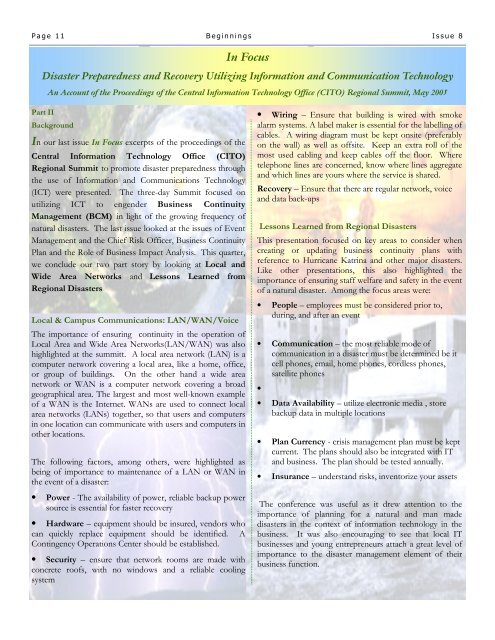Beginnings Issue 8.pub - Planning Institute of Jamaica
Beginnings Issue 8.pub - Planning Institute of Jamaica
Beginnings Issue 8.pub - Planning Institute of Jamaica
You also want an ePaper? Increase the reach of your titles
YUMPU automatically turns print PDFs into web optimized ePapers that Google loves.
P a g e 11 B eginnings I s s u e 8<br />
Part II<br />
Background<br />
In our last issue In Focus excerpts <strong>of</strong> the proceedings <strong>of</strong> the<br />
Central Information Technology Office (CITO)<br />
Regional Summit to promote disaster preparedness through<br />
the use <strong>of</strong> Information and Communications Technology<br />
(ICT) were presented. The three-day Summit focused on<br />
utilizing ICT to engender Business Continuity<br />
Management (BCM) in light <strong>of</strong> the growing frequency <strong>of</strong><br />
natural disasters. The last issue looked at the issues <strong>of</strong> Event<br />
Management and the Chief Risk Officer, Business Continuity<br />
Plan and the Role <strong>of</strong> Business Impact Analysis. This quarter,<br />
we conclude our two part story by looking at Local and<br />
Wide Area Networks and Lessons Learned from<br />
Regional Disasters<br />
Local & Campus Communications: LAN/WAN/Voice<br />
The importance <strong>of</strong> ensuring continuity in the operation <strong>of</strong><br />
Local Area and Wide Area Networks(LAN/WAN) was also<br />
highlighted at the summitt. A local area network (LAN) is a<br />
computer network covering a local area, like a home, <strong>of</strong>fice,<br />
or group <strong>of</strong> buildings. On the other hand a wide area<br />
network or WAN is a computer network covering a broad<br />
geographical area. The largest and most well-known example<br />
<strong>of</strong> a WAN is the Internet. WANs are used to connect local<br />
area networks (LANs) together, so that users and computers<br />
in one location can communicate with users and computers in<br />
other locations.<br />
The following factors, among others, were highlighted as<br />
being <strong>of</strong> importance to maintenance <strong>of</strong> a LAN or WAN in<br />
the event <strong>of</strong> a disaster:<br />
• Power - The availability <strong>of</strong> power, reliable backup power<br />
source is essential for faster recovery<br />
• Hardware – equipment should be insured, vendors who<br />
can quickly replace equipment should be identified. A<br />
Contingency Operations Center should be established.<br />
• Security – ensure that network rooms are made with<br />
concrete ro<strong>of</strong>s, with no windows and a reliable cooling<br />
system<br />
In Focus<br />
Disaster Preparedness and Recovery Utilizing Information and Communication Technology<br />
An Account <strong>of</strong> the Proceedings <strong>of</strong> the Central Information Technology Office (CITO) Regional Summit, May 2005<br />
• Wiring – Ensure that building is wired with smoke<br />
alarm systems. A label maker is essential for the labelling <strong>of</strong><br />
cables. A wiring diagram must be kept onsite (preferably<br />
on the wall) as well as <strong>of</strong>fsite. Keep an extra roll <strong>of</strong> the<br />
most used cabling and keep cables <strong>of</strong>f the floor. Where<br />
telephone lines are concerned, know where lines aggregate<br />
and which lines are yours where the service is shared.<br />
Recovery – Ensure that there are regular network, voice<br />
and data back-ups<br />
Lessons Learned from Regional Disasters<br />
This presentation focused on key areas to consider when<br />
creating or updating business continuity plans with<br />
reference to Hurricane Katrina and other major disasters.<br />
Like other presentations, this also highlighted the<br />
importance <strong>of</strong> ensuring staff welfare and safety in the event<br />
<strong>of</strong> a natural disaster. Among the focus areas were:<br />
• People – employees must be considered prior to,<br />
during, and after an event<br />
• Communication – the most reliable mode <strong>of</strong><br />
communication in a disaster must be determined be it<br />
cell phones, email, home phones, cordless phones,<br />
satellite phones<br />
•<br />
• Data Availability – utilize electronic media , store<br />
backup data in multiple locations<br />
• Plan Currency - crisis management plan must be kept<br />
current. The plans should also be integrated with IT<br />
and business. The plan should be tested annually.<br />
• Insurance – understand risks, inventorize your assets<br />
The conference was useful as it drew attention to the<br />
importance <strong>of</strong> planning for a natural and man made<br />
disasters in the context <strong>of</strong> information technology in the<br />
business. It was also encouraging to see that local IT<br />
businesses and young entrepreneurs attach a great level <strong>of</strong><br />
importance to the disaster management element <strong>of</strong> their<br />
business function.

















